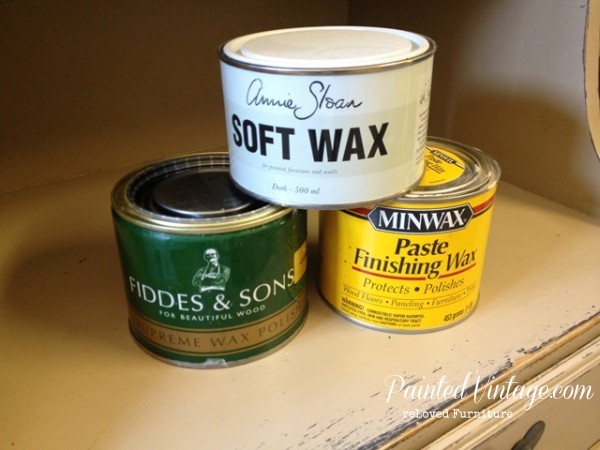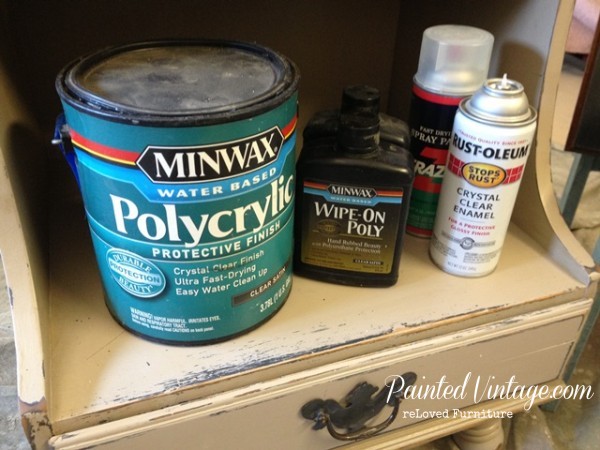To wax or not to wax?
Ah… The age old question: “To wax or not to wax over chalk paint?”
OK, so maybe it isn’t the question that’s been around for as long as chalk paint itself, but it is definitely a dilemma I’ve been facing more and more…
Nothing compares to the soft luster and rich glow of a freshly waxed piece of reLoved furniture!! However, applying wax over chalk paint is the most challenging, labor intensive and time consuming aspect of painting furniture with chalk and chalk-style paint.
Granted, not all waxes are created equal. Some waxes are downright difficult to work with and even require you to take a special class on proper application techniques.
Then there’s the durability issue.
Yes, I have an issue… Wax only offers minimal protection and wax is NOT permanent. Nor is it even semi-permanent. In fact, if it was a hair dye, it would be temporary!!
You see, wax wears off over time with use, leaving your beautiful chalk painted furniture all porous and exposed; a magnet for chocolaty little fingers and cheese puff smudges!
In order to maintain continued protection, wax needs to be reapplied every few months!
But wax isn’t THE ONLY option!
Why not go with a water-based polyurethane sealer, such as Varethane or Polycrylic over chalk paint?
These products are an excellent alternative, and offer far superior protection than a wax. A few coats of polycrylic will last YEARS beyond a few coats of wax, and can be much easier to work with.
Plus, polycrylics are more chemical resistant and are not heat sensitive like wax.
And unlike wax, if you ever chose to repaint your furniture, the polycrylic does not need to be 100% completely removed.
Don’t get me wrong, polycrylics are not without drawbacks.
Although they can have a yellowing effect over white and light colors, I personally have had good success with Varethane staying clear. Some waxes will yellow also, so that can still be an issue if you went that route. (I have also used clear spray-on sealers for smaller projects, with no issues what-so-ever!)
With the ease of application, I am finding water-based polyurethanes to be my go-to finish of choice over chalk painted furniture.
And if you are looking for a good alternative to do-it-yourself chalk-style paint, read my post on an Not So DIY Chalk Paint Recipe.
I’d love to hear your feedback! What is your sealer of choice over chalk paint and chalk-style paint on your reLoved furniture, and what, if any, challenges do you face?
**UPDATE**
Still have questions?? I posted an update with answers to all the most commonly asked questions I’ve received.
You can read it here: “Wax or Polycrylic Over Chalk Paint?”








I can not get polyurethane in the state of MN, Is there anything else? Or am I left with wax as my only option?
Hi Ashley, there are other clear finishes available from various manufacturers. A few you might look into are American Paint Company, Shabby Paints, Safecoat, General Finishes, Paint Couture…
I have thoroughly enjoyed reading all your information! I just chalk painted a cubby/ locker unit for kids costs, shoes, etc. A piece that will take a lot of abuse! I have decided to go the poly and glaze option for durability. I purchased a antiqued glaze by valspar in asphaltum color. It’s very dark. My piece is chateau grey. I’m concerned the glaze will be very dark and ruin it. I will use a test strip. But to be sure I have the correct steps. 1. Chalk paint, dry. 2. Poly 3. Glaze( wipe on and wipe off?) 4. Poly again. Thank you for your help!
Hi Katie, yes, this is correct. The asphaltum is very dark!! Good Luck!
There seems to be a lot of concern about wax and polycrylic. I am a retail partner with Vintage Market & Design Furniture Paint and have been using their chalk based paint and waxes for a long time. You can use their wax and then their Clear Coat with multiple thin coats applied with a damp sponge for a long lasting piece of furniture. The wax must be applied over the paint. It is absorbed into the paint. Any excess should be buffed and can be sealed in twenty four hours. The Clear Coat is always the final application.
Hello, great blog! I’m updating my marble gas fireplace hearth and mantle with a coat of chalk paint. These areas do get a little warm so I’m betting wax is out…what about the water based polyacrylic like Ben Moore Stay Clear?
Sorry, I am not familiar with that product. But a polycrylic should do the trick.
Hi! I am turning a dresser into a bathroom vanity. The top will be sanded and stained a rich darker brown while the bottom and drawers will be painted with blue chalk paint and distressed. What do you suggest sealing the top with to protect it from water?
Thanks!
Amanda
Hi
I just used chalk paint on bunk beds and used wax as the finish but now I am worried it will not hold up over time. When I start to see wear on the ladder can I then do a ploy coat to seal it better or will I still have to use the stuff u said to get it all off. I don’t have the time right now to reduce all of that. Thank u
I have painted a dresser with a blue/green chalk paint and I want the distressed look. Can I use a water based stain to age it before the polycrylic? Should I mix the stain with glaze? Please help, I am totally lost! I don’t want to use the wax.
Than you!! thank you!! First time working with DIY chalk paint and very frustrated with the porous finish that attracts all the dust, I’d wax it but don’t really see the change. Before find this site I’d decide to apply the poly on the top and looks wonderful and now you confirm now what I did.
Poly is the best finish.
Hi ive just used chalk paint then clear waxed over my dinning table, but it’s marking already. If I re paint could I put clear varnish over the top?
Hi Angie, I would try to remove as much wax as possible before repainting. After you repaint, you can then use a water-based polycrylic as a top coat.
I’ve just used Minwax water based poly and I can see that it’s already yellowing. Not great. I was going to wax, but then read this blog. Now I have a yellowing double vanity.
Unfortunately, some polycrylics can have a yellowing effect over white an light colors… As stated in my post “Don’t get me wrong, polycrylics are not without drawbacks. Although they can have a yellowing effect over white and light colors, I personally have had good success with Varethane staying clear. Some waxes will yellow also, so that can still be an issue if you went that route.
I am chalk painting a desk and want to dark wax some areas but want to use Spar Varthane over the chalk – can I then dark wax the accents after and still get the same results? but I can’t then sea; over the wax, correct?
\
Hi Kim. Yes, that is correct.
I’m so glad I read this before my project, I’ve never used chalk paint before, and had no idea what to do. Thank you!
Hi can somebody give me some advice on a lady wants me to paint her kitchen table antique white .. but I dont want to wax as will have hot plates etc . I want a varnish that wont yellow if anyone know s of one can u ļet e know plz
Varathane Crystal Clear formula will not yellow
So … I didn’t wax over a chalk-painted piece … and now it has stains on it (little finger pizza grease marks to be exact). Is there a good way to clean that without ruining the paint or am I doomed? I was hoping maybe I could use white vinegar or something? Advice?
Curious… Did the white vinegar work?
I apologize- haven’t read all of the comments!! But is it okay to apply a poly ON TOP of an already waxed piece??
No, but you can wax on top of poly…